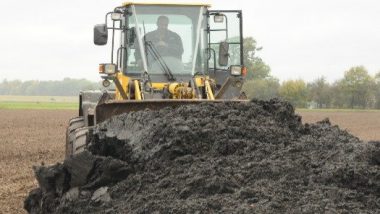Turning waste into watts
About 20 per cent of our greenhouse gas emissions are related to the production, processing, transportation and storage of food.
But a third of the food we buy in Britain ends up being thrown away.
As a nation, we waste 6.7million tonnes of food every year. In response, this month the Government taskforce Waste and Resources Action Programme (Wrap) has just launched a campaign to tackle food waste.
Yet it’s not just about cutting down what we chuck in the bin – the way we dispose of our banana skins and coffee grinds has to change, too.
Britain is facing fines of up to £180million – payable by taxpayers – for failing to meet targets on reducing landfill waste.
Forthcoming EU legislation will ban biodegradable waste (raw food, cooked food and vegetation) from landfill sites.
The new laws will reduce levels of rubbish and tackle climate change: methane is emitted when biodegradable waste is broken down in landfill.
But what if there was a technology that broke down biodegradable waste into a biogas that could be converted into electricity or heat?
This is the potential of anaerobic digesters – an advanced form of composting that’s gradually gaining prominence thanks to the combined forces of enlightened farmers, eco-entrepreneurs, pressure groups such as Friends of the Earth and Government initiatives such as Wrap.
It’s a technology being developed to help deal with our mounting waste crisis and provide a source of renewable energy.
Anaerobic digestion is a stage beyond what many of us are already doing with home composting.
It involves breaking down food waste (whether cooked, raw or half-eaten), as well as paper, cardboard, animal waste, sewage and industrial effluents, in an oxygen-free environment.
This process produces biogas, which can be used to power and heat the anaerobic digester (making it self-sufficient) and create electricity that can be fed back into the national grid.
Award-winning cheese farmer Patrick Berridge, based in Wexford, Ireland, is a staunch advocate of anaerobic digesters. ‘I’ve had an anaerobic digester on my farm for ten years,’ he says.
‘I first saw them in poultry farms in New Zealand in the 1970s and ended up building my own.
‘It’s a 300-tonne tank with lots of modifications and I’m currently converting my old slurry storage tank into another anaerobic digester with a capacity of 1,200 tonnes.’
As a dairy farmer with a constant flow of animal waste from his herd of cows, constructing and housing an anaerobic digester makes perfect sense for Berridge.
The digester provides enough electricity and heat to power both the process itself and his entire farm. Berridge also makes revenue by charging a gate fee for local farmers to dispose of their biodegradable waste. via Turning waste into watts
Advanced anaerobic digestion in Ireland: An analysis
Current and future picture for Anaerobic Digestion (AD) and advanced anaerobic digestion (AAD)
There are 14 wastewater treatment plants in Ireland with anaerobic digestion (AD) currently in operation. In 2014, these processed more than 50 per cent of all wastewater sludges, which will increase to 65 per cent once wastewater treatment plant upgrades are completed.
Within Irish Water’s National Wastewater Sludge Management Plan, the number of AD sites will increase to 19, and by 2040 the total mass of wastewater sludge in Ireland is projected to increase by 80 per cent to 96,000 tonnes of dry solids. Advanced Anaerobic Digestion (AAD) is deemed the lowest carbon footprint and most economically feasible option for processing these sludges.
What does AD and AAD achieve and what is possible?
Anaerobic digestion is the conversion of organics (also termed volatile solids) into biogas, which is largely composed of methane (about 60 per cent) and carbon dioxide (~40 per cent), plus digestate. The feed sludge organic fraction is approximately 75 to 80 per cent, the remainder being ash/inorganic solids, which are conserved during digestion.
For sewage sludges, conventional mesophilic anaerobic digestion will destroy 30 to 40 per cent of the organics present, whereas advanced anaerobic digestion may achieve 60 per cent or more. Therefore, AAD will reduce the overall mass of solids more than conventional AD and produce a greater quantity of biogas. via AAD-Ireland
EPA welcomes an increase in composting and anaerobic digestion of waste
EPA welcomes an increase in composting and anaerobic digestion of waste:
- The EPA welcomes the increase in composting and anaerobic digestion of biodegradable waste – the quantity recycled increased by 15 per cent between 2015 and 2016.
- Kitchen & canteen food waste and park & garden waste accounted for most of the waste accepted for treatment in 2016 (65 per cent).
- Composting rather than anaerobic digestion was the dominant treatment type.
The EPA has released data and information on composting and anaerobic digestion in Ireland for 2016. The data updates the National Waste Statistics web resource, launched by the EPA in recent months.
Commenting on the figures, Stephen Treacy, EPA, said:
“The EPA welcomes the increase in the amount of biodegradable waste being accepted for recycling at composting and anaerobic digestion plants. Ireland’s national waste management policy “A Resource Opportunity” aims to make the most of opportunities to recover resources from waste in line with the European Commission’s Circular Economy Strategy. Segregating and separately collecting biodegradable wastes such as food and garden waste means that they can be recycled and reduces the amount disposed to landfill.”
EPA figures show that the amount of waste accepted at commercial composting and anaerobic digestion plants increased by 15 per cent between 2015 and 2016 (from 308,000 tonnes to 353,000 tonnes). Composting was the dominant treatment activity (79 per cent of tonnage accepted). via EPALean-Business-Ireland






(You might helpfully have included a URL link to the video in your emailed abstract)
Did the consultant also give the potential savings by AD (or AAD) over Composting Please?
If not, what are they?
Brian – Yes, sorry no link. The video was completed later than intended, due to a delay from a glitch in the video production software while creating the video. The emailer grabbed the article and sent it out before I could finish the video, and add the link!
I presume that by savings you refer to CO2 emission savings. No I don’t see any comparison of composting with AD (or AAD) in Report 3. I am assuming that you are reasoning that if for example the OFMSW is not put through an AD plant, it is most likely to be composted.
As composting (aerobic decomposition) will be the same reaction whether or not it is done in a composting facility, or the material (eg grass) is simply mown and left in-place, the reason may be simply that there is no CO2 saving for composting?
I am not at all confident that what I say is correct so I suggest that you would do best to ask IrBEA direct: http://www.irbea.org
I hope that helps?